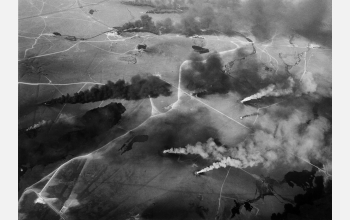Multimedia Gallery
Kuwait oil fires set by retreating Iraqi troops
An aerial view of Kuwait oil fires set by retreating Iraqi troops in the last days of the Persian Gulf War (late 1990 to early 1991). The resulting inferno emitted large amounts of carbon dioxide and other gases into the atmosphere, while locally the thick smoke blocked sunlight, lowered temperatures, and engulfed the area in a mist of microscopic oil droplets.
National Science Foundation-funded researchers collected data on the ground and in the air using heavily instrumented planes. This was some of the most extensive data collected on the atmospheric behavior of the fire's giant smoke plumes.
Credit: Robert Bumpas, NCAR
Images and other media in the National Science Foundation Multimedia Gallery are available for use in print and electronic material by NSF employees, members of the media, university staff, teachers and the general public. All media in the gallery are intended for personal, educational and nonprofit/non-commercial use only.
Images credited to the National Science Foundation, a federal agency, are in the public domain. The images were created by employees of the United States Government as part of their official duties or prepared by contractors as "works for hire" for NSF. You may freely use NSF-credited images and, at your discretion, credit NSF with a "Courtesy: National Science Foundation" notation.
Additional information about general usage can be found in Conditions.
Also Available:
Download the high-resolution JPG version of the image. (4 MB)
Use your mouse to right-click (Mac users may need to Ctrl-click) the link above and choose the option that will save the file or target to your computer.



